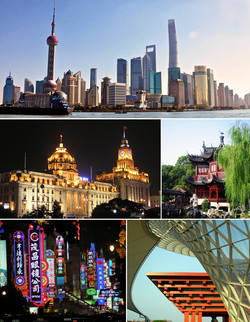上海
|
Shanghai 上海市 |
|
|---|---|
| Municipality | |
| Shanghai Municipality | |

Clockwise from top: A view of the Pudong skyline, Yu Garden, China pavilion at Expo 2010 along with the Expo Axis, neon signs on Nanjing Road, and The Bund
|
|
| Etymology: 上海浦 (Shànghăi Pǔ) "The original name of the Huangpu River." |
|
 Location of Shanghai Municipality in China |
|
| Coordinates: 31°13′43″N 121°28′29″E / 31.22861°N 121.47472°ECoordinates: 31°13′43″N 121°28′29″E / 31.22861°N 121.47472°E | |
| Country |
|
| Settled | c. 4000 BC |
| Establishment of - Qinglong Town |
746 |
| - Shanghai County | 1292 |
| - Municipality | 7 July 1927 |
| Divisions - County-level - Township- level |
16 districts 210 towns and subdistricts |
| Government | |
| • Type | Municipality |
| • Party Secretary | Han Zheng |
| • Mayor | Ying Yong |
| • Congress Chairman | Yin Yicui |
| • Conference Chairman | Wu Zhiming |
| Area | |
| • Municipality | 6,341 km2 (2,448 sq mi) |
| • Water | 697 km2 (269 sq mi) |
| Elevation | 4 m (13 ft) |
| Population (2015) | |
| • Municipality | 24,150,000 |
| • Rank | 1st in China |
| • Density | 3,800/km2 (9,900/sq mi) |
| • Metro (2010) | 34,000,000 |
| Demonym(s) | Shanghainese |
| Time zone | CST (UTC+8) |
| Postal code | 200000–202100 |
| Area code(s) | 21 |
| Nominal GDP | 2016 |
| - Total |
¥2.75 trillion $414 billion (11th) |
| - Per capita |
¥113,719 $17,125 (3rd) |
| - Growth |
|
| HDI (2014) | 0.852 (4th) – very high |
| Licence plate prefixes | 沪A, 沪B, 沪D-沪H, 沪J-沪N 沪C (outer suburbs) |
| Abbreviation | SH / 沪 (hù) |
| City flower | Yulan magnolia |
| Languages | Shanghainese, Mandarin |
| Website | www |
| Shanghai | |||||||||||||||||||||||||||||||||||||||
|
"Shanghai" in regular Chinese characters
|
|||||||||||||||||||||||||||||||||||||||
| Chinese | 上海 | ||||||||||||||||||||||||||||||||||||||
|---|---|---|---|---|---|---|---|---|---|---|---|---|---|---|---|---|---|---|---|---|---|---|---|---|---|---|---|---|---|---|---|---|---|---|---|---|---|---|---|
| Wu | |||||||||||||||||||||||||||||||||||||||
| Literal meaning | "Upon-the-Sea" | ||||||||||||||||||||||||||||||||||||||
|
|||||||||||||||||||||||||||||||||||||||
| Transcriptions | |
|---|---|
| Standard Mandarin | |
| Hanyu Pinyin | Shànghǎi |
| Gwoyeu Romatzyh | Shanqhae |
| Wade–Giles | Shang4-hai3 |
| IPA |
[ʂâŋ.xài] ( |
| Wu | |
| Romanization | |
|
Shanghainese Romanization |
Zånhae |
| Hakka | |
| Romanization | Sông-hói |
| Yue: Cantonese | |
| Yale Romanization | Seuhng-hói |
| IPA | [sœ̀ːŋ.hɔ̌ːy] |
| Jyutping | Soeng6-hoi2 |
| Southern Min | |
| Hokkien POJ | Siōng-hái |
| Eastern Min | |
| Fuzhou BUC | Siông-hāi |
Shanghai is one of the four direct-controlled municipalities of China and the most populous city proper in the world with a population of more than 24 million as of 2014[update]. It is a global financial centre and transport hub, with the world's busiest container port. Located in the Yangtze River Delta, it sits on the south edge of the estuary of the Yangtze in the middle portion of the East China coast. The municipality borders the provinces of Jiangsu and Zhejiang to the north, south and west, and is bounded to the east by the East China Sea.
As a major administrative, shipping and trading city, Shanghai grew in importance in the 19th century due to trade and recognition of its favourable port location and economic potential. The city was one of five treaty ports forced open to foreign trade following the British victory over China in the First Opium War. The subsequent 1842 Treaty of Nanking and 1844 Treaty of Whampoa allowed the establishment of the Shanghai International Settlement and the French Concession. The city then flourished as a centre of commerce between China and other parts of the world (predominantly Western countries), and became the primary financial hub of the Asia-Pacific region in the 1930s. However, with the Communist Party takeover of the mainland in 1949, trade was limited to other socialist countries, and the city's global influence declined. In the 1990s, the economic reforms introduced by Deng Xiaoping resulted in an intense re-development of the city, aiding the return of finance and foreign investment to the city.
...
Wikipedia
